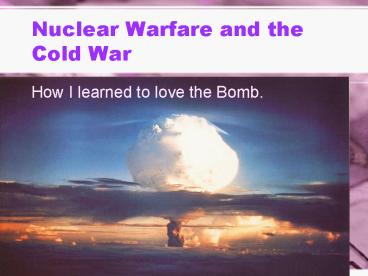Nuclear Warfare and the Cold War - PowerPoint PPT Presentation
1 / 16
Title:
Nuclear Warfare and the Cold War
Description:
Nuclear Warfare and the Cold War How I learned to love the Bomb. Fission Nuclear weapons Atomic bomb Uranium 235 atoms are split in a chain reaction This causes a ... – PowerPoint PPT presentation
Number of Views:531
Avg rating:3.0/5.0
Title: Nuclear Warfare and the Cold War
1
Nuclear Warfare and the Cold War
- How I learned to love the Bomb.
2
FissionNuclear weaponsAtomic bomb
- Uranium 235 atoms are split in a chain reaction
- This causes a massive release of energy
- Basic Nuclear Fission
3
FusionThermonuclear weaponsHydrogen bomb
- Hydrogen Isotopes are forced together to create
energy process that powers sun. - Needs a fission explosion to create enough heat
and pressure to start reaction - Creates much bigger explosion
4
What is yield?
- The power of nuclear and thermonuclear explosions
are expressed in tons of TNT equivalent explosive
power. - Nuclear weapons are in Kilotons(kt)
- Thermonuclear weapons are in Megatons(mt)
- The Hiroshima bomb was 16-18 kt
- The largest ever detonated was 59 mt
5
Delivery(or how to send nuclear joy to your
enemy)
- 1st bombs were delivered like any other bomb.by
airplane. - This was the primary method of delivery until the
mid 50s. - By 1980 their where several ways to deliver
nuclear weapons - Airplane, Artillery, Missile
- There were several varieties of each.
6
Airplanes
- Bombers original means of delivery since early
bombs were big and needed big airplanes - As the Cold War progressed advances in tech
produced smaller weapons and a greater diversity
of airplane delivery systems. - Today most military combat aircraft can deliver
some sort of nuclear weapon - Bombers tend to be strategic and fighters/fighter
bombers tend to be tactical
7
Artillery
- By the late 50s nuclear weapons had been reduced
in size so they could fit into large cannons. - These were developed to use smaller atomic
weapons on the battlefield. - These are called tactical nuclear weapons.
8
MissilesGuided missiles to be accurate
- There are 2 types of guided missiles
- Ballistic launched very high in big arcing
trajectory - Cruise flies like an airplane low to the
ground. - Germans were the first to develop both in WW2
- V1 cruise and V2 ballistic
9
Ballistic missiles
- Ballistic missiles are categorized by range
- Short range ballistic missile SRBM
- Medium range ballistic missile MRBM
- Intermediate IRBM
- Intercontinental - ICBM
10
Submarines
- By the early 60s the US developed nuclear powered
submarines - They also developed a system to launch ballistic
missiles from submarines - These are called SLBMs
- The submarines are called Ballistic missile
Submarines or boomers - Primarily strategic in nature.
11
Cruise missiles
- Fly like an airplane
- Can be launched from
- the ground (GLCM)
- From airplanes (ALCM)
- From ships and subs (SLCM)
- Tend to be more accurate and have a shorter range
than ballistic missiles - Can be used tactically or strategically
12
Other developments
- MIRV Multiple Independent Reentry Vehicle
- Basically putting many warheads on one missile.
- Done in response to restrictions on the number of
missiles - Neutron Bomb enhanced radiation device
- Developed to be used against Warsaw Pact Armies
- Reduces physical damage of explosion while being
lethal to people - Tactical nuclear weapon
13
Defending against Nuclear Weapons
- Airplanes Shoot them down before they get to
target - Cruise missiles very hard to shoot down
- Ballistic missiles- almost impossible to shoot
down ABM systems - ABM Anti-Ballistic Missile
- Early ones such as Nike-Hercules used nuclear
warheads - Not very effective
14
How to fight a nuclear war.
- First Strike take out your enemies nuclear
forces before he can use them against you - Deterance have enough nukes to survive or
launch counter-strike before his weapons arrive - MAD Mutual Assured Destruction
- When both sides have enough nukes and delivery
systems to ensure that they can launch a
retaliatory strike that will destroy the attacker - Came about when the USSR finally had enough ICBMs
to hit US.
15
How each side organized its nuclear forces.
- US developed nuclear Triad
- Equal distribution of strategic nuclear weapons
among bombers, submarines and ballistic missiles - Allowed greater flexiblity and less vulnerability
- USSR had mostly ICBMs
- 70 of Soviet strategic nukes in silos in ICBMs,
rest in subs and bombers
16
Effects of nukes
- Detailed effects on a few american cities
- http//www.atomicarchive.com/Example/index.shtml
- Blast radius based on size
- http//www.fas.org/main/content.jsp?formAction297
contentId367 - List of US nukes
- http//nuclearweaponarchive.org/Usa/Weapons/Allbom
bs.html













![The Cold War [1945-1991]: An Ideological Struggle PowerPoint PPT Presentation](https://s3.amazonaws.com/images.powershow.com/6028748.th0.jpg?_=20150126033)

















![get [PDF] DOWNLOAD If War Comes Tomorrow? (Soviet (Russian) Military T PowerPoint PPT Presentation](https://s3.amazonaws.com/images.powershow.com/10121847.th0.jpg?_=20240906043)